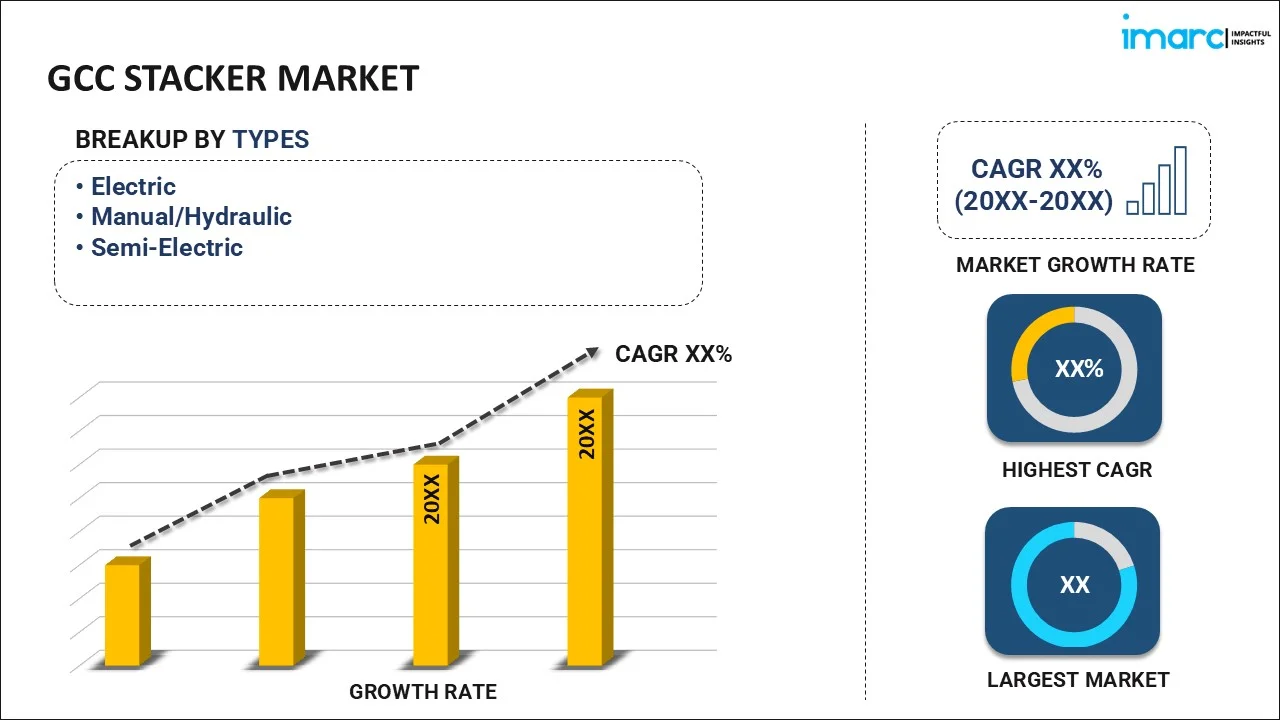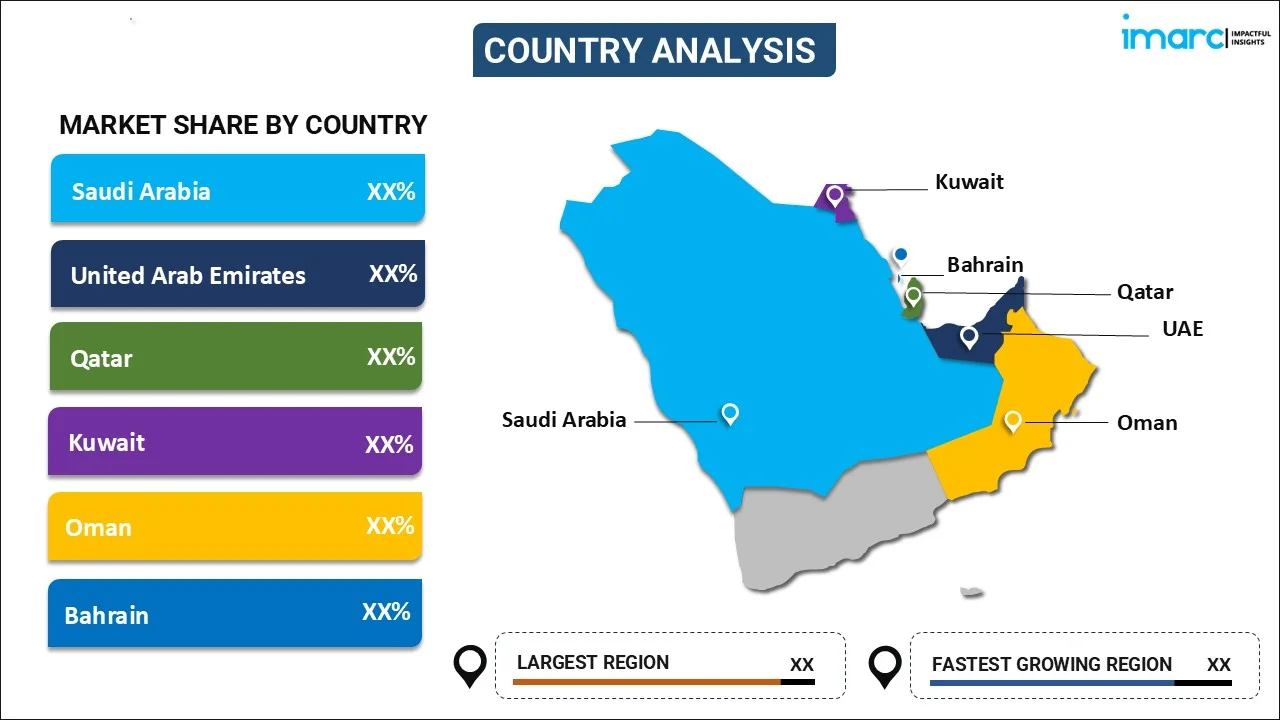
GCC Stacker Market Report by Type (Electric, Manual/Hydraulic, Semi-Electric), End User (Retail and Wholesale, Logistics, Automobile, Food and Beverages, and Others), and Country 2025-2033
Market Overview:
The GCC stacker market size reached USD 44 Million in 2024. Looking forward, IMARC Group expects the market to reach USD 71 Million by 2033, exhibiting a growth rate (CAGR) of 5.3% during 2025-2033. The growing infrastructural development activities, the adoption of battery-operated stackers for handling double pallets and facilitating horizontal transport, and the rising focus on sustainability and environmental consciousness represent some of the key factors driving the market.
|
Report Attribute
|
Key Statistics
|
|---|---|
|
Base Year
|
2024 |
|
Forecast Years
|
2025-2033
|
|
Historical Years
|
2019-2024
|
| Market Size in 2024 | USD 44 Million |
| Market Forecast in 2033 | USD 71 Million |
| Market Growth Rate (2025-2033) | 5.3% |
Stacker is an essential industrial machine utilized in a wide range of sectors to efficiently handle, stack, and transport heavy loads such as pallets, containers, and various other materials. It consists of a sturdy frame powered by electric or internal combustion engines, allowing it to perform heavy-duty tasks with ease. The machine is equipped with a hydraulic lifting system, which grants it the ability to hoist materials to considerable heights, enabling multi-tiered stacking, thus maximizing vertical storage space. It comes in both manual and automated configurations. This robust and versatile equipment plays a vital role in warehouse management, manufacturing facilities, distribution centers, ports, and construction sites, significantly enhancing productivity and optimizing logistics operations. The primary function of a stacker is to lift and stack materials in a systematic manner, facilitating orderly storage and ease of retrieval. Manual stackers are maneuvered by an operator who controls the machine's movements, while automated stackers are integrated with advanced technology such as sensors, cameras, and programmable logic controllers (PLCs) to perform tasks autonomously, reducing human intervention and optimizing efficiency.
GCC Stacker Market Trends:
The growing infrastructural development activities are driving the market in GCC. Moreover, the rapid advancement of automation and Industry 4.0 technologies is catalyzing the market as these intelligent stackers reduce the need for manual intervention, leading to enhanced productivity and cost savings for businesses. In line with this, the introduction of automated robotic stackers has also played a crucial role in impelling the market outlook since these solutions not only reduce labor costs but also prevent injuries, improve package quality, and prove to be indispensable during seasonal labor shortages. Moreover, the widespread use of stackers in handling automobiles, be it in repair shops, car showrooms, or vertical car parking, has further propelled market growth. Besides, with the rise in online shopping, warehouses, and fulfillment centers require stickers to manage and handle the high volume of goods efficiently. Stackers play a crucial role in streamlining order fulfillment processes, optimizing storage space, and reducing order processing time, thereby meeting the demands of the fast-paced e-commerce industry. Additionally, the adoption of battery-operated stackers for handling double pallets and facilitating horizontal transport has seen an upward trend. Besides, extensive research and development (R&D) efforts aimed at enhancing the product's construction, functionality, and durability are contributing to the market. Furthermore, the growing focus on sustainability and environmental consciousness has driven the demand for eco-friendly stackers. Electric-powered stackers and those using alternative fuel sources are gaining popularity as companies seek to reduce their carbon footprint and achieve environmentally sustainable practices.
GCC Stacker Market Segmentation:
IMARC Group provides an analysis of the key trends in each segment of the GCC stacker market report, along with forecasts at the regional and country levels for 2025-2033. Our report has categorized the market based on type and end user.
Type Insights:

- Electric
- Manual/Hydraulic
- Semi-Electric
The report has provided a detailed breakup and analysis of the GCC stacker market based on the type. This includes electric, manual/hydraulic, and semi-electric.
End User Insights:
- Retail and Wholesale
- Logistics
- Automobile
- Food and Beverages
- Others
A detailed breakup and analysis of the GCC stacker market based on the end user has also been provided in the report. This includes retail and wholesale, logistics, automobile, food and beverages, and others.
Country Insights:

- Saudi Arabia
- UAE
- Qatar
- Bahrain
- Kuwait
- Oman
The report has also provided a comprehensive analysis of all the major regional markets, which include Saudi Arabia, UAE, Qatar, Bahrain, Kuwait, and Oman.
Competitive Landscape:
The report has also provided a comprehensive analysis of the competitive landscape in the GCC stacker market. Competitive analysis such as market structure, key player positioning, top winning strategies, competitive dashboard, and company evaluation quadrant has been covered in the report. Also, detailed profiles of all major companies have been provided.
GCC Stacker Market Report Coverage:
| Report Features | Details |
|---|---|
| Base Year of the Analysis | 2024 |
| Historical Period | 2019-2024 |
| Forecast Period | 2025-2033 |
| Units | Million USD |
| Scope of the Report | Exploration of Historical and Forecast Trends, Industry Catalysts and Challenges, Segment-Wise Historical and Predictive Market Assessment:
|
| Types Covered | Electric, Manual/Hydraulic, Semi-Electric |
| End Users Covered | Retail And Wholesale, Logistics, Automobile, Food And Beverages, Others |
| Countries Covered | Saudi Arabia, UAE, Qatar, Bahrain, Kuwait, Oman |
| Customization Scope | 10% Free Customization |
| Post-Sale Analyst Support | 10-12 Weeks |
| Delivery Format | PDF and Excel through Email (We can also provide the editable version of the report in PPT/Word format on special request) |
Key Questions Answered in This Report:
- How has the GCC stacker market performed so far and how will it perform in the coming years?
- What has been the impact of COVID-19 on the GCC stacker market?
- What is the breakup of the GCC stacker market on the basis of type?
- What is the breakup of the GCC stacker market on the basis of end user?
- What are the various stages in the value chain of the GCC stacker market?
- What are the key driving factors and challenges in the GCC stacker market?
- What is the structure of the GCC stacker market and who are the key players?
- What is the degree of competition in the GCC stacker market?
Key Benefits for Stakeholders:
- IMARC’s report offers a comprehensive quantitative analysis of various market segments, historical and current market trends, market forecasts, and dynamics of the GCC stacker market from 2019-2033.
- The research study provides the latest information on the market drivers, challenges, and opportunities in the GCC stacker market.
- Porter's five forces analysis assist stakeholders in assessing the impact of new entrants, competitive rivalry, supplier power, buyer power, and the threat of substitution. It helps stakeholders to analyze the level of competition within the GCC stacker industry and its attractiveness.
- Competitive landscape allows stakeholders to understand their competitive environment and provides an insight into the current positions of key players in the market.
Need more help?
- Speak to our experienced analysts for insights on the current market scenarios.
- Include additional segments and countries to customize the report as per your requirement.
- Gain an unparalleled competitive advantage in your domain by understanding how to utilize the report and positively impacting your operations and revenue.
- For further assistance, please connect with our analysts.
 Request Customization
Request Customization
 Speak to an Analyst
Speak to an Analyst
 Request Brochure
Request Brochure
 Inquire Before Buying
Inquire Before Buying




.webp)




.webp)












